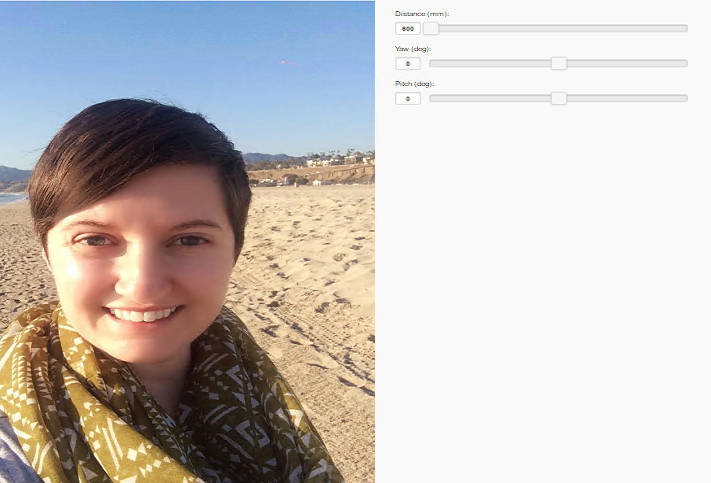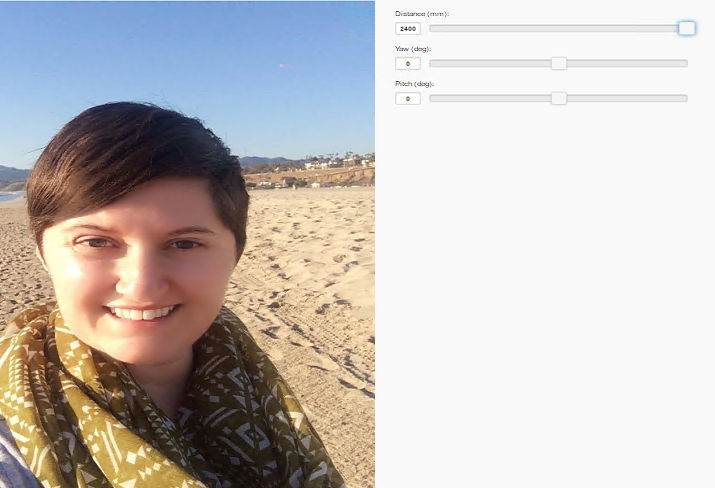| Selfie Righteous - Corrects Selfie Perspective |
| Written by David Conrad |
| Wednesday, 03 August 2016 |
|
This is news that had to be covered, if only for the name of the new technique - Selfie Righteous is a name to contemplate. The idea is simple enough, but are enough people aware that there is a problem to be corrected?
Before I'm tired of saying how wonderful computational photography is - but it is. Long gone are the days when a camera was just a piece of glass and some photosensitive plastic. Now we can change and correct just about any defect of the physical equipment - or subject for that matter! Have you noticed that selfies are, well, how to put it, not really of the self you know and love? If you don't realize that you look strange in a selfie it is probably because your most common view of yourself is in a mirror, which as well as being left-right reversed is a close up. The problem is, to put it into perspective, is exactly that, perspective. If you get up close to a subject and use a short focal length lens to make this possible then the normal perspective is distorted to something unusual. It is not that close up perspective is wrong it is just that it is not what we are used to. Normal perspective is what you get when you frame a human head and shoulders using a 50mm (full frame) lens. Mobile phone cameras have a much shorter effective focal length lens and when you take a selfie you get an exaggerated perspective, a.k.a big nose syndrome. If this unflattering? Well clearly not very as people keep on taking selfies - or is it just people with overly small noses who keep on taking selfies? Researchers at Princeton now have a correction method that will put your nose, among other things back its rightful place. Although there is a hint that even the researchers might not be 100% confident that people notice the problem. Ohad Fried, lead developer of the method and a Ph.D. candidate in the Department of Computer Science at Princeton University, said: “Although it is the age of the selfie, many people are unaware of how much these self-portraits do not really look like the person being photographed because the camera is way too close. Now that people can edit so many aspects of a photo right on their phones, we wanted to provide a quick way to edit faces that maintains realism.” A quick way yes but don't underestimate the computational complexity of the task. In a paper presented at this year's SIGGRAPH conference Adam Finkelstein and his team explain how they use 3D modeling of the human head and map this onto 72 reference points on the face in the selfie. Next the warping needed for the reference points to move them to locations appropriate for a camera further away and with a different focal length lens is computed. Not only can perspective be corrected in this way, but slight shifts in camera angle can also be accommodated - selfies generally look better from higher camera angles. Take a look at the method and some results:
The team hopes that its editor will make selfie sticks obsolete - and this is something we can all share. The method has some problems, including the difficulty of warping hair, but it looks as if it could be a product sometime soon. In addition to correcting perspective, once you have a 3D model and the ability warp to different view points, you can use it to create anaglyphs - red/green stereo photos. If you want to try it out for yourself there is a site where you can upload your own photos and use sliders to adjust perspective and camera angle.
After More Informationhttp://faces.cs.princeton.edu/ http://gfx.cs.princeton.edu/gfx/pubs/Fried_2016_PMO/index.php Related ArticlesGoogle Presents --- Motion Stills Removing Reflections And Obstructions From Photos Google - We Have Ways Of Making You Smile New Algorithm Takes Spoilers Out of Pics
To be informed about new articles on I Programmer, sign up for our weekly newsletter, subscribe to the RSS feed and follow us on, Twitter, Facebook, Google+ or Linkedin.
Comments
or email your comment to: comments@i-programmer.info
|
| Last Updated ( Wednesday, 03 August 2016 ) |




